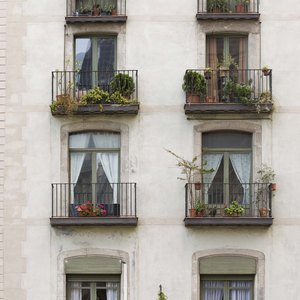
When you buy a home within a building or other common ownership community, you may be charged monthly fees in addition to your mortgage. This is particularly true in communities that have shared amenities such as a pool, tennis courts or common areas. From a practical standpoint, it may seem that a fee is a fee, whether paid to a condo board or a homeowners' association (HOA). Yet, condo fees and HOA fees are different.
What is a Condominium?
Understanding the definition of a condo is important to understanding condo fees. In a condo, each owner owns his individual units and an undivided interest in the common elements. The boundaries of the individual residence are defined in documents developed when the condo was established but typically are from the unit's drywall inward and the interior area of the concrete slab upwards.
Common elements typically include the roof, elevators, halls, lobby and facilities such as a pool or fitness center. A council of all the owners elects a board of directors to govern the condo and to be responsible for maintaining, repairing and replacing all common elements.
Condo Operating Fees
Each year the board of directors determines the operational costs for the condo and divides this cost among the owners based upon their ownership share as indicated in the documents drawn up when the condo was established. Ownership share can be equal; for example, 1/10 if the building contains 10 units. Alternatively, ownership share can be based upon the size of the individual unit; the larger the size, the larger the share. Condo fees sometimes include utilities.
What is an HOA?
An HOA is comprised of homeowners residing within a particular area and can exist in a townhouse or single-family home community. It establishes covenants or rules about how homeowners may maintain, paint or use their property. The HOA, rather than the property owners, own the common areas such as tennis courts or green spaces.
Property owners within the community are granted the right to use these common areas through an easement. In these communities, unlike a condo, property owners also own the external walls of their home (or, in the case of townhouses, share ownership with the next-door neighbor), as well as the land on which their home sits. Exterior additions or improvements require approval of an architectural committee or the HOA board of directors.
HOA Assessment Fees
As with condominium fees, HOA fees are developed by determining the budget and dividing the cost among homeowners in the form of assessments against their lot. An owner's obligation is determined by the total cost divided by the number of lots. Because HOAs are responsible for maintaining proportionally smaller common areas, HOA fees tend to be smaller than those of a condominium of similar size. HOA fees seldom include utilities.
References
- National Council of State Housing Authorities. "FHA Issues New Review Requirements for Condominium Loans." Accessed May 11, 2020.
- First Heritage Mortgage. "What Is a Non-Warrantable Condo?" Accessed May 11, 2020.
- United States Government. "Code of Federal Regulations: Title 24, Housing and Urban Development. Part 234, Condominium Ownership Mortgage Insurance." Accessed May 11, 2020.
Writer Bio
Randi Hicks Rowe is a former journalist, public relations professional and executive in a Fortune 500 company, and currently a formation minister in the Episcopal Church. She has been published in Security Management, American Indian Report and Tech Republic.She has a bachelor's in communications, a master of arts in Christian education and a master of business administration.

